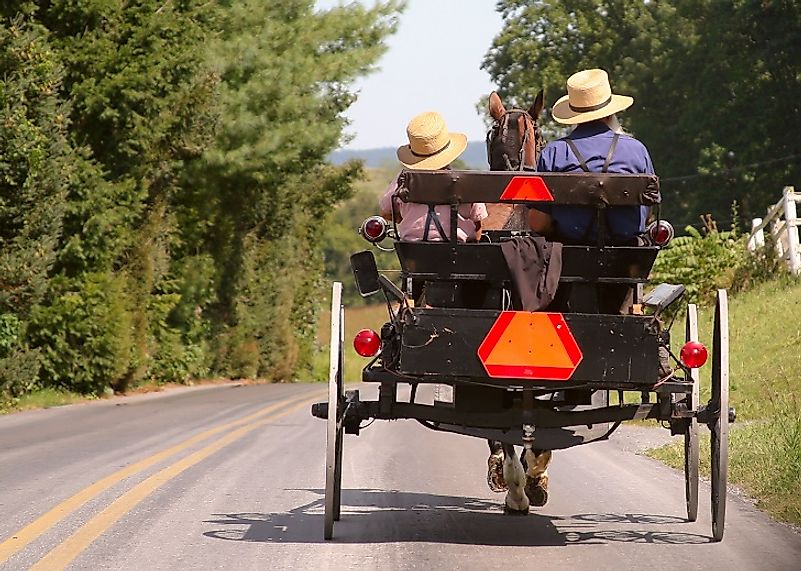The Amish - Cultures Around the World

5. Description
The Amish are a group of traditional Christians who share Swiss Anabaptist origins with the Mennonite people. These people are known for their adherence to a simple way of life, which also involves a reluctance towards the acceptance of modern technologies. In 1693, a schism in Switzerland, created within a group of Swiss and Alsatian Anabaptists, led to the formation of the "Amish Order". They were so named in reference to the fact that they were people who followed the teachings of Jakob Ammann, one of the leaders of the schism. In the early 18th Century, a large portion of the Amish population migrated to Pennsylvania from their homelands in Europe. Today, the traditional Amish speak the Pennsylvanian Dutch (or Pennsylvanian German) language, while a smaller section of the Old Order Amish in Indiana uses Swiss German as their means of communication within their community.
4. Architecture
The belief of the Amish culture in simplicity and a life devoid of worldly pleasures is reflected in their architectural styles. Traditional Amish homes are simple structures with little attention given to either exterior or interior designing and detailing. When one visits an Old Order Amish neighborhood, it is easy to tell a difference between them and other neighbourhoods in the region. The first thing that will draw attention is the absence of electricity power lines. Also, the signature Amish farm home has a distinct angular look with an exterior made of white, (often peeling) painted wood, a metal roof, and a companion windmill. The interior of traditional Amish homes appear to be simple as well, having durable linoleum floors, soft light colors, and minimal decoration. Wide open spaces are usually included in these homes in order to host large groups of people during community or family gatherings. For the Amish, the home is a sacred place, and hence they keep electricity, phones and other modern amenities away from their dwellings to maintain the integrity of their domiciles.
3. Cuisine
The Amish cuisine is unique in its tastes and ingredients, as well as the names of its dishes. Apples seem to be a favorite ingredient in Amish cuisine, prominently featured in a number of famous Amish dishes including apples as one of their major ingredients, such as apple butter, apple fritters, Schnitz un Knepp, apple dumplings. As the Amish avoid wasting anything edible, often their cuisine involves animal parts that most people cannot imagine consuming. "Scrapple" is one such dish, made from leftover scraps of meat from a butcher’s store, cornmeal, and buckwheat flour, formed to create a loaf-like patty. Other traditional Amish dishes include bott boi (a meat stew), Dutch spiced pot roast, getulte rinderbrust (beef dishes seasoned with spices), Hasenpfeffer (marinated and browned rabbit meat served with Dutch sour cream), hog maw (pig’s stomach stuffed with vegetables and spices and then baked or broiled), leber kloese (beef liver dumplings), and zitterting (cooked meat from pigs' feet). Besides the above dishes, the Amish also make their own contribution to the dessert arena, with such delectable fare for those with a sweet tooth as fasnachts (a doughnut-like treat), shoofly pie (made from molasses, brown sugar, butter and water), and whoopie pie (two disk-shaped chocolate cakes with whipped or butter cream sandwiched in between them).
2. Cultural Significance
Amish culture significantly stresses a plain way of life accompanied by a detachment from worldly desires. To the orthodox Amish, the world outside their society is full of vanity and vice, and by following the strict norms of Amish life and giving up materialistic pleasures, the Amish may be able to achieve their spiritual goals. Products from the modern world that appear to threaten the Amish values are strictly prohibited in Amish homes and daily life. They prefer to wear plain clothing in black, white, or mute colors that give minimum attention to style and cut in order to prevent attracting glances towards the wearer. Amish furniture also has typical features of its own, and is often made completely from wood. It is shaped and formed by way of manual, hydraulic, or pneumatic power instead of electricity. The Amish also believe in maintaining strong unity within their community, and do not condone marriages of their members outside of their own Amish circle.
1. Threats
The simple pastoral lifestyle that the Amish have conserved for centuries appears to be threatened by the pressures of modernization inherent to the 21st century. The infiltration of new outside populations, equipped with their modern technologies, into Amish territories could result in a gradual eradication of the Amish culture. The practice of a 17th Century lifestyle in a 21st Century world also seems to place the Amish at risk of losing their way of life in the competitive world. The spread of modern education and entry of the Amish people into outside business fields could also stray the Amish from their plain ways, in favor of more modern, technology-driven ones. Rapid urbanization nearby has led to the entry of electricity and other modern amenities into many Amish homes and settlements, threatening the traditional beliefs of the Amish community. However, the fact that, amidst such highly competitive pressures, a significant portion of the Amish population has still managed to preserve their old traditions and beliefs, is definitely praiseworthy.







